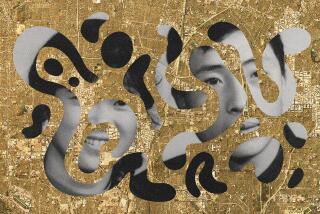Korean churches growing rapidly
Six days a week in Koreatown, hundreds of people converge on Oriental Mission Church for a prayer service before sunrise.
Some worshipers inch their way to the base of the cross on their knees. Others raise their arms heavenward, calling out, âHana-nim Aboji! (Father God), or Joo-yoh! (Lord Jesus).â Some just sit, weeping.
The scene is repeated at Korean congregations throughout Southern California, with thousands of Korean Americans packing churches for predawn services before hustling off to work or school.
Korean immigrants in Greater Los Angeles have established the biggest Korean community outside Asia, and their growing influence on the business community is well known. Perhaps less obvious is the extraordinary growth of Korean churches, which tend to practice a brand of Christianity emphasizing daily worship and missionary work.
Experts say that nearly 80% of Korean immigrants attend church. By comparison, a study by the Pew Forum on Religion & Public Life this year found that 54% of Americans went to church weekly, more than once a week or a few times a month. The rest attended services occasionally or not at all.
âThe local church is the center of fellowship, comfort and consolation,â said Anselm K. Min, professor of philosophy of religion and theology at Claremont Graduate University.
An association of Korean Protestant churches in Southern California has 1,359 congregations, representing 39 denominations. A study last year by the L2 Foundation, a Christian group that strives to develop Asian American leadership, found that of 7,000 Protestant Asian congregations in the U.S., 4,000 were Korean.
The Rev. Hee-Min Park, a respected pastor and former missionary who pastored Korean churches in L.A. and Toronto, attributes the proliferation of the immigrant churches to the huge influx of Koreans since the 1970s, the growth of Korean seminaries and a tendency for congregations to split when they run into disagreements. âOur strong points are passion, prayer and evangelism,â he said.
Yet for all that vibrancy, some Korean Americans are wondering when and how Korean churches will interact more with other institutions in the region. They cite some tendencies in Korean church life: a reluctance to work in partnership with other churches and not paying sufficient attention to social justice issues.
âWe are a little weak in living out our faith in social action,â said Ho Chung, a former Garden Grove councilman and Korean American community leader. âBut in terms of vision and faith and sincerity and enthusiasm, Korean Christians are incomparable.â
Missionaries brought Christianity to the Korean peninsula a century ago. Before the partition of the country after World War II, two-thirds of Christians lived in the north. Pyongyang, now the capital of North Korea, was known as the âJerusalem of the East.â Today, South Korea is considered the most Christian nation in East Asia.
Estimates put the U.S. Korean population at 1.2 million, and researchers say the vast majority are Christian.
Min believes Christianity appeals to Koreans because it demands unconditional commitment, which blends well with the Korean work ethic and emphasis on achievement.
But Donald N. Clark, a history professor at Trinity University in San Antonio, who as a missionary kid and Peace Corps volunteer spent years in Korea, says the cost of discipleship has been high. He said Korean Christians are âoften held up as sacrificial, dedicated and a suffering communityâ because of the struggles theyâve been through under the Japanese colonial rule -- Christians were persecuted for refusing to bow at Shinto shrines -- the partition after World War II, and then the Korean War. The tradition of daily dawn services began in Korea, as did another Korean church import -- red crosses on church buildings.
Another import is an exuberant worship style. Grace Korean Church in Fullerton stands out. When the congregation sings hymns -- led by a âworship teamâ and accompanied by an orchestra and a full choir -- the sanctuary feels like a music hall. Some worshipers get up and dance. At times, the Rev. Paul Gilhong Han, senior pastor, will urge congregants, âLetâs give Jesus a big hand!â The sound of applause then fills the sanctuary.
More to Read
Sign up for Essential California
The most important California stories and recommendations in your inbox every morning.
You may occasionally receive promotional content from the Los Angeles Times.










